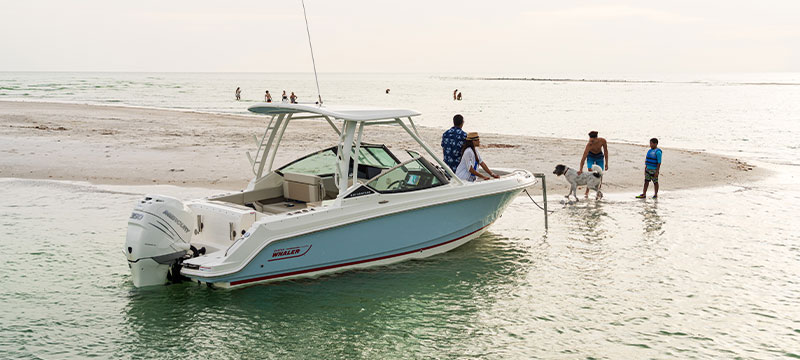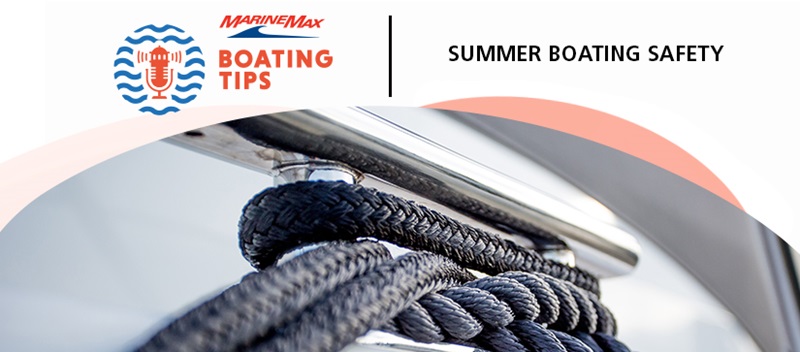Boating Tips: Summer Boating Safety
Boating Tips
Summer Boating Safety
Summer Boating Safety: A Guide for Enjoying the Water
Summer is here! Enjoy this helpful guide to learn how to have a safe and enjoyable summer on the water.
Mastering the Art of Anchoring
1.Setting the Bow Anchor:
To anchor your boat at the beach, you'll need two anchors. Begin by setting your bow anchor. If your boat has a windlass, like the Boston Whaler featured in our video, start by releasing the cable. Use the remote control to lower the anchor. As the chain runs out, you'll reach the anchor rode (rope).
2. Reversing Towards the Beach
Once the anchor is down, head back to the helm. Slowly reverse your boat towards the beach. As you approach shallower waters, trim up your engines to avoid hitting the sand. You'll feel the plow anchor set into the ground as you reverse, ensuring it's firmly dug in.
3. Setting the Stern Anchor:
With the bow anchor secure, it's time to set the stern anchor. Tie the line to a cleat and toss the stern anchor towards the shore. This dual-anchor setup stabilizes your boat, keeping it from swaying or drifting.
4. Securing and Retrieving Anchors:
When you're ready to leave, simply walk over and pick up the stern anchor. Pull back on it, keeping it taut as you walk towards the boat. This method ensures a smooth retrieval process.
Remember, the key to successful anchoring is ensuring both anchors are well set and secure.
Staying Safe In the Summer Sun
Boating is fun, but the summer sun can be harsh. Here's how to protect yourself and your crew:1. Sun Protection Gear:
- Sunglasses: Protect your eyes with high-quality sunglasses.
- Hats: A wide-brimmed hat keeps the sun off your face and neck.
- Dry-Fit Shirts: Wear SPF-rated clothing to shield your skin from harmful UV rays.
2. Sunscreen:
Always use a high-quality, name-brand sunscreen. Apply it generously and reapply as needed. Regular skin checks and using sunscreen can prevent painful sunburns and long-term skin damage.
Understanding Wave Forecasts
Knowing how to read wave forecasts is crucial for a safe boating experience:
1. Wind and Wave Indicators:
Pay attention to wind direction and speed. Flags standing out and bent over indicate strong winds.
2. Wave Height and Frequency:
Wave forecasts often include wave height and the interval between waves. For example, a 4-foot wave height with a 4-second interval means rough conditions, like a washing machine - just non-stop. Conversely, waves 12 seconds apart are smoother and more comfortable.
3. Real-Time Weather Data:
Utilize apps and weather buoys to get real-time data on wave conditions. This information helps you decide whether it's safe to head out or stay ashore.
Captain’s Orientation: Know Your Boat
No matter the size of your boat, from a 13-foot Boston Whaler Super Sport to a large Ocean Alexander yacht, it's essential to be familiar with its operation. When you buy your boat at MarineMax, this comes with your purchase and we walk you through each of the items below.
- Button Functions: Learn the purpose of each button at the helm.
- Safety Protocols: Understand the throttle-only feature (if your boat is equipped with this feature) to prevent accidental movements.
- VHF Radio Usage: Know communication protocols.
- Power Systems: Familiarize yourself with the main distribution panel and power supply.
Before setting off, ensure everything is working correctly, and you're comfortable with all the boat's systems.
Final Thoughts
Boating is a wonderful way to enjoy the summer, but safety should always come first. By having a good understanding of the items mentioned here, you'll ensure a safe and enjoyable experience on the water.
See you out on the water! Stay safe and happy boating! Check out more of our MarineMax Boating Tips videos and see what you can learn from Captain Keith!
Check Out Available Boats

The Boating Lifestyles Blog

Find Your Perfect Boat Today


